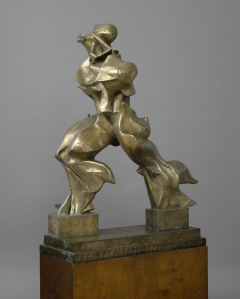History of Abstraction
- artedelic
- Aug 26, 2015
- 3 min read
AIP1, Session 17
ABSTRACT ART - any painting/scuplture that doesn't portray recognisable objects/scenes.
The basic idea of abstraction is that the formal qualities of art (shapes, colours, etc.) are just as important, if not more so, than its representational qualities.
Abstract art is a result of the first modern art movement---IMPRESSIONISM. Though impressionist paintings are derived from the real world (commonly scenery or people) its colour palettes and painting methods are non-naturalistic. The emergence of abstract art was also influenced by the Art Noveau movement.
Up until the 19th century, most paintings and sculptures followed the traditional principles of Classical Realism, which was, "Art's duty is to provide a recognisable scene/object."
Developments in modern art led to a wider colour palette, rejection of the 3D perspective (depth) and introduced new shapes.
Some artists like Picasso thinks there is no definition to abstract art, while some art critics view all art as abstract---because a painting is only a crude summary of the artist's perception.
"Remember that a picture, before being a war horse or a nude woman...
is essentially a flat surface covered with colours assembled in a certain order."
- Maurice Denis
In this session, I was asked to choose ten artists and ten different abstract art movements.
CLAUDE MONET
14 Nov 1840 - 5 Dec 1926
Impressionism is a 19th-century art movement that originated in Paris. Early impressionists broke the rules of academic painting, thus becoming the first modern art movement. Impressionism values liberally-brushed colours over lines and contours. They often included passages of time in their paintings, used short brush strokes and pure unmixed colour to achieve an intense colour vibration. Impressionism recreates the sensation of the moment instead of "freezing" its subjects in time.
HENRI MATISSE
31 Dec 1869 - 3 Nov 1954
Fauvist paintings were characterised by their strident colours and simplified (abstract) subjects. The brushwork seems random and wild, though Matisse also explored collages, as seen with his cutout works.
GEORGES BRAQUE
13 May 1882 - 31 Aug 1963
Braque played a large role in the development of cubism---an avant garde movement, probably the most influental one of the 20th century. It's a reaction towards the pretty, decorative impressionism paintings. Cubism rejects depth, and keeps everything on a 2-dimensional flat plane.
DAVID BOMBERG
5 Dec 1890 - 19 Aug 1957
Vorticism is a movement that rejects landscapes and nudes as its subject but instead focuses on a geometric style, as well as angular simplification. However, it was a short-lived movement, as the artists shifted their sympathy to the unfolding human disaster of WW1.
UMBERTO BOCCIONI
19 Oct 1882 - 17 Aug 1916
The futurism art movement emphasised speed, technology, youth, violence and modern objects such as cars and airplanes. It also led to the development of kinetic art, which emphasises on virtual movement.
KAZIMIR MALEVICH
23 Feb 1878 - 15 May 1935
The suprematist art movement focuses on basic geometric forms such as squares, circles and lines, painted in a limited range of colours. It originated in Russia.
PIET MONDRIAN
7 Mar 1872 - 1 Feb 1944
De Stijl, also called Neo Plasticism was a Dutch art movement that believes in the ultimate simplicity and abstraction. It only uses straight vertical and horizontal lines and rectangular forms, and its palette is limited to the three primary colours and primary values.
MARK ROTHKO
25 Sept 1903 - 25 Feb 1970
The colour field painting movement originated in New York City during the 40s and 50s. It was inspired by European modernism and is closely related to abstract expressionism. It proposes that colour be freed from objective context and thus, becomes the subject itself.
GEORGES MATHIEU
27 Jan 1921 - 10 Jun 2012
Tachisme is derived from the French word "tache", which means "stain". It was part of a larger postwar movement known as the Art Informel, which abandoned geometric abstraction in favour of a more intuitive form of expression. It's closely related to lyric abstraction.
PAUL JENKINS
12 Jul 1923 - 9 Jun 2012
Lyric abstraction, related to abstract expressionism, is a movement that opposes cubist and surrealist movements as well as geometric abstraction ("cold abstraction"). It's seen as the French answer to the American abstract expressionism. Lyric abstraction promotes harmony and intuitive expression.
























































Comments